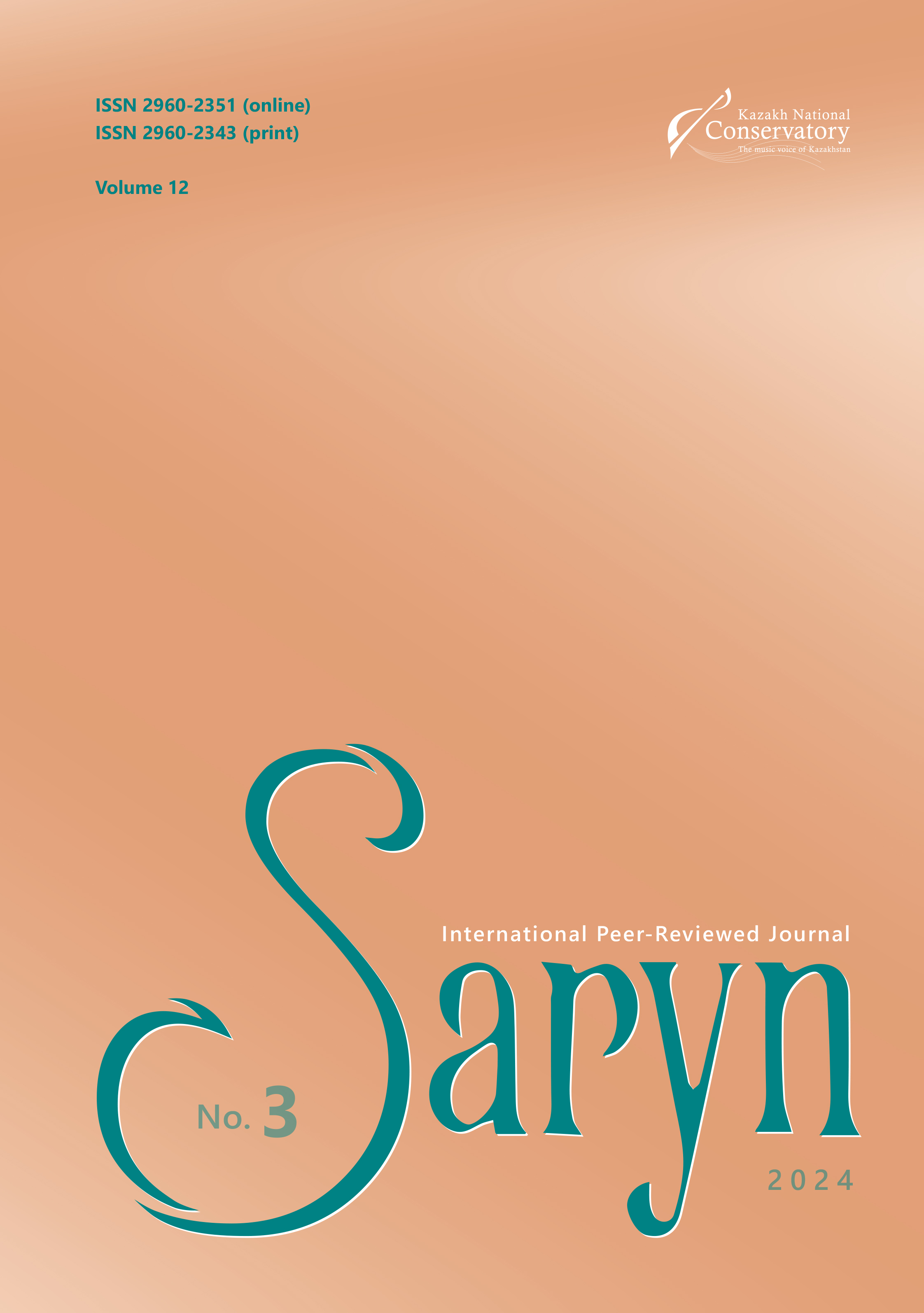Article information
Article publication date
2024-09-23
Article Page
20–33
Chapter
Arts & Humanities
License
Abstract
This article aims to explore the unity of song and the stylistic interaction between pop and academic art in Kazakhstani songwriting and performing practice. Using the performing art of R. Baglanova as an example, we will examine the role of song in the works of Kazakhstani composers and performers, analyse the general features of R. Baglanova's vocal art in the context of the development of Kazakh song during the Soviet period, and identify stylistic directions in her repertoire and individual originality in sound production and intonation.
The intersections between pop and academic song styles are one of the trends in the work of composers of Kazakhstan, who compose songs along with operas and ballets, large-scale and chamber vocal and orchestral works. The expressive features of the song "Tan Samaly" by E. Rakhmadiev are determined. Its uniqueness lies in the organic combination of the tradition of Kazakh folk songmaking and the vocal style of chamber song and romance lyrics. In its structure, the features of a complex form are noted: continuous melodic growth based on the singing of tones of the tonic triad. Both pop artists with a traditional singing style and classical academic singers perform the song "Tan Samaly." Rosa Baglanova has created an unsurpassed example of interpretation of this masterpiece of Kazakh music of the 20th century. She enriched the song culture, aimed at a broad audience.
The cross-influences of intra-genre stylistic trends in the song "Tan Samaly" and in the art of its interpretation by R. Baglanova outline two mutually directed processes between the creativity of composers and performers. Therefore, along with the established separate study of the varieties of song (folklore, academic, and pop), the unity of the national song culture is methodologically important.
Keywords
Roza Baglanova
Kazakh music of the 20th century
folk song
pop song
“Tan Samaly”
overlap of styles
intra-genre style trends
academic singing
pop singing
traditional song-making
References
Abdirakhman, Gulnar. Sovremennoe samodeyatelnoe pesnetvorchestvo v kazahskoj muzykalnoj culture [Contemporary Amateur Songwriting in Kazakh Musical Culture]. Almaty, Soros Foundation-Kazakhstan, 2002. (In Russian)
Baglanova, Roza. Ainalayyn khalkymnan yerketken: kazak sakhnasyn, kumis komei anshinin omiri men shygarmashylygy hakynda [Pampered by the Beloved Peoples: The Life and Work of a Unique Natural Talent of the Kazakh Scene]. Almaty, Atamura, 2007. (In Kazakh)
Bodaubai, Bolat. Tangalamyn өmirdin gazhabyna: syr-suhbatka kurylgan gumyrnamalyk roman [Admiring the Miracle of Life: Autobiographical Novel Constructed in the Form of Intimate Conversations]. Astana, Foliant, 2010. (In Kazakh)
Hauser, Marc, et al. “The Faculty of Language: What Is It, Who Has It, and How Did It Evolve?” Science, vol. 298, no. 5598, 2002, pp. 1569–1579. DOI: 10.1126/science.298.5598.1569
Konen, Valentina. Tretij plast: novye massovye zhanry v muzyke XX veka [The Third Layer: New Mass Genres in Music of the Twentieth Century]. Moscow, Music, 1994. (In Russian)
Kuzembayeva, Sara, and Toizhan Yeginbayeva. Lekcii po istorii kazahskoj muzyki: Uchebnoe posobie [Lectures on the History of Kazakh Music: Textbook]. Almaty, 2005. (In Russian)
Li, Ang. “The Historical Evolution of the Popularization of Classical Music and the Development of the Fusion of Multiple Musical Styles.” Herança, vol. 7, no. 1, 2024, pp. 113–125. DOI: 10.52152/heranca.v7i1.810.
Lomax, Alan. The Folk Songs of North America in the English Language: A Handbook of Music Information. New York, Doubleday & Company Inc, 1960.
Ouyang, Yiwen. Westernization, Ideology and National Identity in 20th-Century Chinese Music. 2012, Royal Holloway, University of London, PhD thesis, pure.royalholloway.ac.uk/en/publications/westernisation-ideology-and-national-identity-in-20th-century-chi. Accessed 28 January 2024.
Sultanova, Razia. “Music and Identity in Central Asia: Introduction.” Ethnomusicology Forum, vol. 14, no. 2, 2005, pp. 131–142. DOI: 10.1080/17411910500329989.
Zemtsovsky, Izaliy. “Melosfera Musorgskogo – ego ‘neizvestnaya rodina’.” [Mussorgsky’s Melosphere – His “Unexplored Homeland.”] Muzykalnaya akademiya, no. 3, 2012, pp. 30–35. (In Russian)




